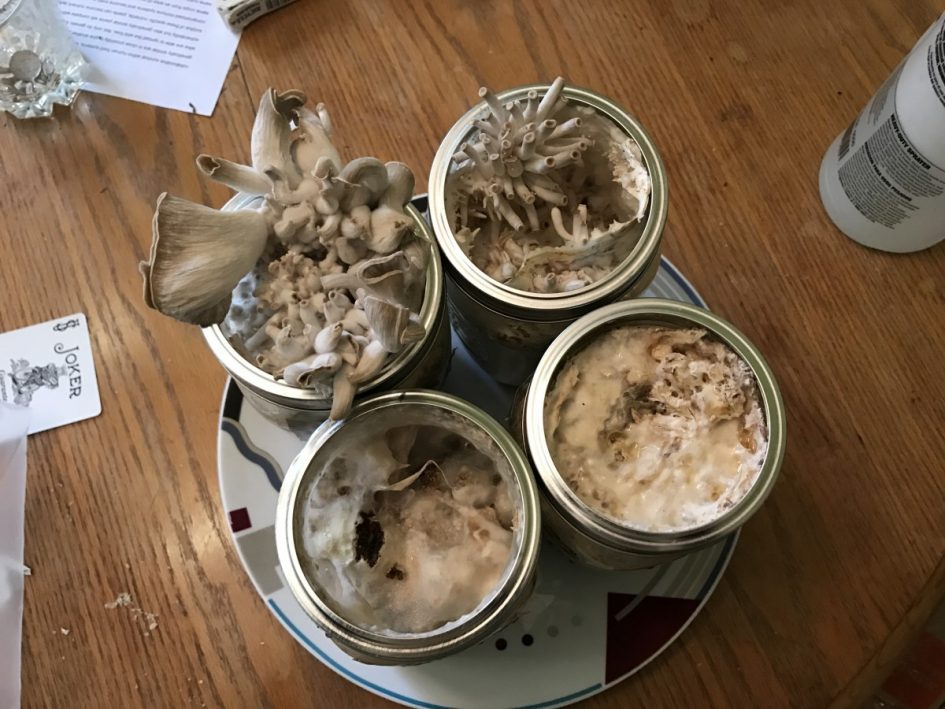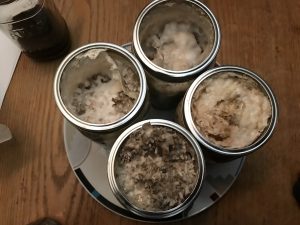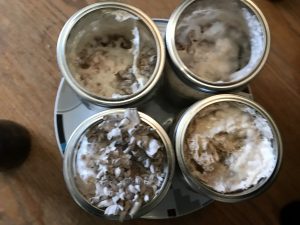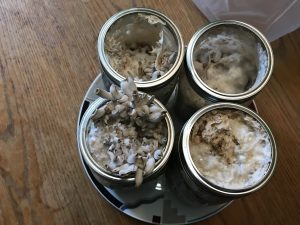Day 8 of fruiting
Erik Drews
SOSComAlt
Weekly Project Update 7
Mushooms
As it is now week 7 I have decided to stop inoculating grains for this quarter because there will not be enough time left in the quarter for newly
inoculated grains to actually fruit into mushrooms. I currently have 24 jars of inoculated spent grains from 4 different types of beer being colonized by both shiitake and oyster mushroom mycelium. 3 shiitake jars of rye pale ale grains, 3 oyster jars of rye pale ale grains, 3 shiitake jars of all wheat ale grains, 3 oyster jars of all wheat ale grains, 3 shiitake jars of stout grains, 3 oyster jars of stout grains, 3 shiitake jars of smoked red ale grains, and 3 oyster jars of smoked red ale grains. Of these, all of the rye pale ale grains along with all of the full wheat ale grains are as colonized as they have the potential to become. This being said, these fully colonized jars are ready to be transitioned to fruiting. Fruiting conditions are slightly different that colonization conditions. Fruiting is induced by adjusting temperatures, oxygen levels, and humidity. Ideally the fully colonized jars of grain spawn would be used to inoculate a larger substrate before fruiting is induced. In the case of oyster mushrooms, this larger substrate could be straw, wood chips, corn cobs, or a bucket of spent grains from brewing. Each grain spawn jar contains anywhere from 1 to 2 lbs of grain spawn. 1 lb of fully colonized grain spawn can be used to inoculate around 5 lbs of bulk substrate. With oyster mushrooms, inoculation is the process of breaking up the grain spawn and then mixing it evenly into the pasteurized bulk substrate. Shiitake mushrooms are a little more picky when it comes to the types of substrates that they are able to fruit off of. One way that shiitake grain spawn is commonly used is the process of taking a recently cut hard-wood log and cutting it into thick slices, then the spawn can be sandwiched in between these slices and the slices are then toe-nailed back together. This allows for the shiitake mycelium to colonize the hard-wood log prior to fruiting. These processes of expanding the substrate prior to fruiting allows for much higher mushroom yields but takes significantly longer than fruiting less mushrooms directly out of the jars of grain spawn. Due to our time limitations, I have decided to use one shiitake jar of both the rye pale ale grains and the all wheat ale grains, along with one oyster jar of both the rye pale ale and the all wheat ale grains to induce fruiting directly out of the jars. I have induced fruiting by opening the jars increasing oxygen levels and putting them on a plate with a humidity tent over them. The jars that are colonized my oyster mushroom mycelium had visible primordia upon opening the jars and have begun fruiting quite successfully, however the jars that are colonized with shiitake mushroom mycelium have not been forming primordia. This could be for a number of reasons, one being that the spent grains may be an inadequate fruiting substrate for shiitake mycelium and another possible cause for this may be that the shiitake mycelium may require cold shocking in order to induce fruiting. I will try spraying the open jars of shiitake mycelium with cold water to see if this encourages primordia formation.







Leave a Reply